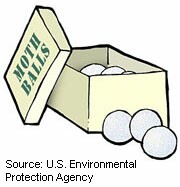
MONDAY, March 22 (HealthDay News) — Labels on some common household pesticide products lack clear information about how to use them safely, a new study shows.
Directions suggest that “if a little is good, more is better,” which could lead consumers to use excessive amounts of pesticides that could pose a threat to the health of family members and pets, according to the California Environmental Protection Agency researchers.
Linda M. Hall and colleagues analyzed labels on mothballs and other products that contain a chemical called para-dichlorobenzene (pDCB). Other products with the chemical are used to protect caged birds against lice and mites and for mildew prevention.
“Recently, several national studies have shown that minority groups including African-Americans and Hispanics are likely to have elevated blood levels of a variety of indoor air pollutants. Very important among these indoor air pollutants is pDCB, the mothball ingredient. All uses of pDCB in California are residential. Therefore, it is important that labels clearly define conditions for safe use by untrained residential consumers,” Hall said in a news release.
However, the researchers found that the product labels specify a minimum rate of application and a minimum treatment time but don’t mention the maximum amount for safe use.
“While this label sets conditions to protect against the pest insects, it allows consumers to follow the old adage, ‘if a little is good, more is better’! Thus, there is no limit on the amount that may be used per cubic foot of storage space. This might account, in part, for the high levels of pDCB seen among some consumers,” Hall said.
In addition, the labels make no mention of how long clothing should be aired to dissipate pDCB that has seeped into the fabric.
“Thus, the consumer, following label instructions, might take clothing saturated with pDCB fumes directly from storage and wear it immediately,” Hall said. “Because no airing conditions are specified, consumers who find the pDCB odor unpleasant and do air clothing, might air it indoors, further contributing to human exposure to this substance.”
The study was to be presented Monday at the national meeting of the American Chemical Society.
More information
The U.S. Environmental Protection Agency offers pesticide safety tips.

